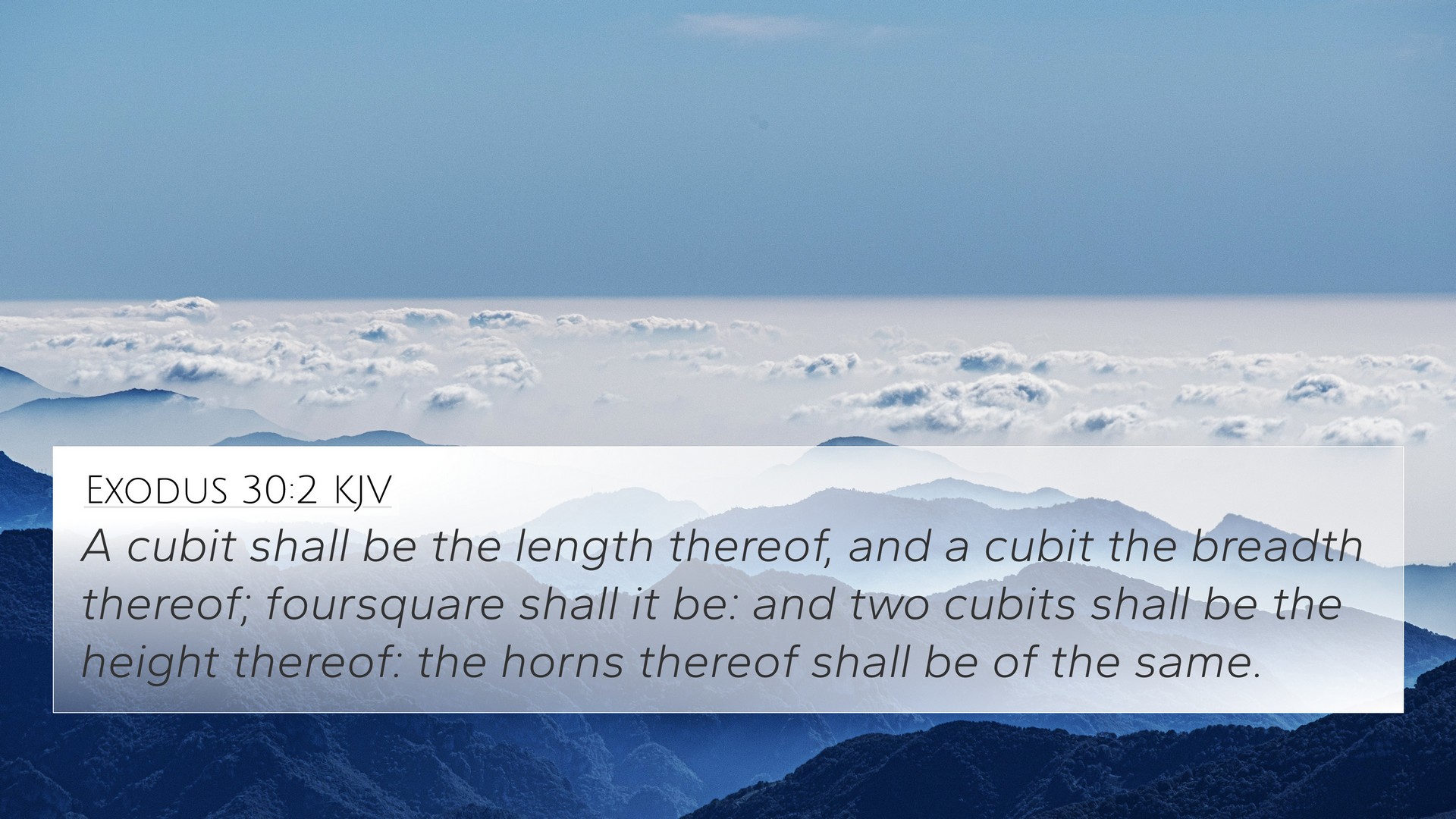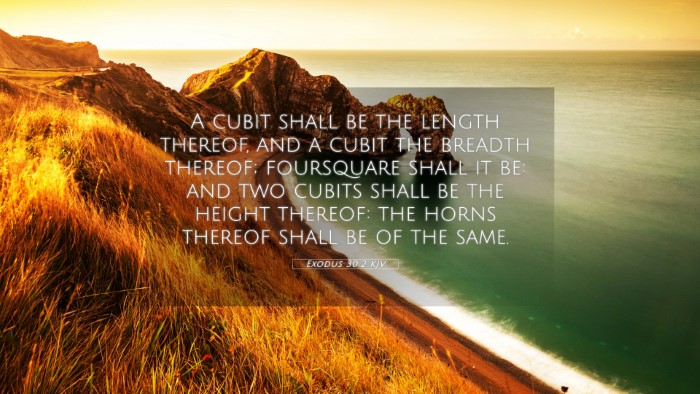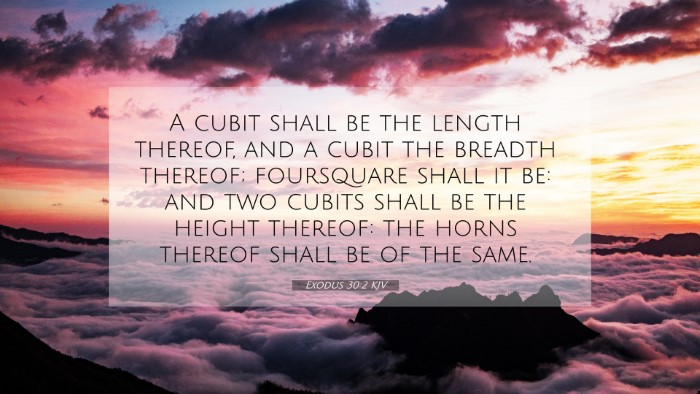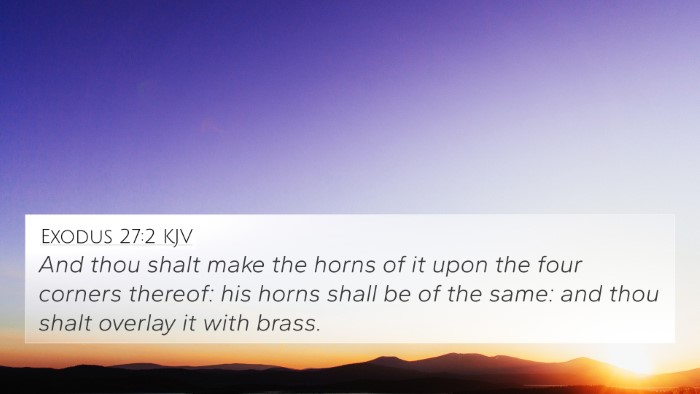Summary of Exodus 30:2
Exodus 30:2 reads: “A cubit shall be the length of it, and a cubit the breadth of it; the altar shall be square: and the height of it shall be three cubits.” This verse details the dimensions of the altar for burnt offerings, reflecting God's requirements for worship.
Meaning and Interpretation
The instructions for the altar represent not only the physical specifications God set forth for His people but also underscore the importance of careful obedience to divine command. The altar symbolizes the place of sacrificial offerings to God, a site central to Israel's worship and relationship with Him.
Commentary Insights
-
Matthew Henry:
Henry emphasizes that the altar's design illustrates God’s orderliness and the importance of adhering to His specifications — both in the physical layout of worship and in the spiritual life of the believer.
-
Albert Barnes:
Barnes notes that the dimensions, being cubic, signify perfection and completeness, hinting that the altar is a complete offering to God. He stresses its height as indicative of the elevation of the offerings as they ascend to God.
-
Adam Clarke:
Clarke provides insight into the deeper implications of the altar’s construction, pointing out that it serves as a symbol of Christ, the ultimate sacrifice. He holds that the specifics of the altar are vital in understanding how God desires to be worshipped.
Bible Verse Cross-References
Exodus 30:2 connects with several other scriptures that enhance our understanding of its meaning. Here are relevant cross-references:
- Hebrews 13:10 - Points to the altar where Christ offered Himself as a sacrifice.
- Revelation 6:9 - References the souls of martyrs under the altar, symbolizing the ultimate sacrifice for faith.
- Romans 12:1 - "Present your bodies as a living sacrifice," drawing a parallel to the ancient sacrificial system.
- Leviticus 9:24 - Discusses the fire coming from the altar, representing God’s acceptance of offerings.
- 1 Peter 2:5 - Believers are called living stones, being built into a spiritual house, echoing the sacrificial nature of worship.
- Colossians 1:20 - Highlights reconciliation through Christ's sacrifice, which parallels the offerings made on the altar.
- 1 Corinthians 10:21 - Discusses the nature of participating in the communion of the altar, linking back to the observance of the sacrificial system outlined in Exodus.
Connections Between Bible Verses
Understanding Exodus 30:2 requires looking at the broader biblical context. The altar's specifications represent a pattern in scripture where God provides detailed instructions regarding worship. These themes stress the importance of God's presence, holiness, and the centrality of sacrifice in seeking communion with Him.
Thematic Bible Verse Connections
Throughout scripture, themes of sacrifice and worship are consistently linked. Notably:
- The role of sacrifice: Establishes the essential nature of atonement. For example, Genesis 4:4 addresses Abel's offering, which sets a precedent for acceptable worship.
- God's response to offerings: God's acceptance or rejection is reflected in 1 Samuel 15:22, emphasizing obedience over sacrifice.
- Significance of the temple: John 2:19-21 reflects Jesus speaking of His body as a temple, linking to the sacrificial system of the Old Testament and the practices described in Exodus.
Analytical Approach
This verse serves as a point of analysis for both Old and New Testament scripture, revealing connections through the lens of sacrifice and worship. Through comparative analysis of these verses, deeper insights into God’s requirements for holiness and the ultimate sacrifice of Christ emerge.
Inter-Biblical Dialogue
The dialogue between Exodus and the New Testament showcases an evolution in understanding sacrificial practice, from animal offerings to the singular offering of Jesus Christ. This transformative theme invites believers to explore how ancient practices inform contemporary faith.
Conclusion
The careful design of the altar in Exodus 30:2 not only reflects God's specifications but also symbolizes a profound theological truth about sacrifice and relationship with God. By linking relevant scripture, believers can grasp the holistic biblical narrative that informs worship and understanding of God's plan through Jesus Christ.



